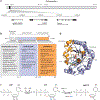Viperin Reveals Its True Function
- PMID: 32603630
- PMCID: PMC8191541
- DOI: 10.1146/annurev-virology-011720-095930
Viperin Reveals Its True Function
Abstract
Most cells respond to viral infections by activating innate immune pathways that lead to the induction of antiviral restriction factors. One such factor, viperin, was discovered almost two decades ago based on its induction during viral infection. Since then, viperin has been shown to possess activity against numerous viruses via multiple proposed mechanisms. Most recently, however, viperin was demonstrated to catalyze the conversion of cytidine triphosphate (CTP) to 3'-deoxy-3',4'-didehydro-CTP (ddhCTP), a previously unknown ribonucleotide. Incorporation of ddhCTP causes premature termination of RNA synthesis by the RNA-dependent RNA polymerase of some viruses. To date, production of ddhCTP by viperin represents the only activity of viperin that links its enzymatic activity directly to an antiviral mechanism in human cells. This review examines the multiple antiviral mechanisms and biological functions attributed to viperin.
Keywords: RNA-dependent RNA polymerase; RSAD2; chain terminator; interferon; radical SAM protein; viperin.
Figures



Similar articles
-
A naturally occurring antiviral ribonucleotide encoded by the human genome.Nature. 2018 Jun;558(7711):610-614. doi: 10.1038/s41586-018-0238-4. Epub 2018 Jun 20. Nature. 2018. PMID: 29925952 Free PMC article.
-
Viperin, through its radical-SAM activity, depletes cellular nucleotide pools and interferes with mitochondrial metabolism to inhibit viral replication.FEBS Lett. 2020 May;594(10):1624-1630. doi: 10.1002/1873-3468.13761. Epub 2020 Mar 2. FEBS Lett. 2020. PMID: 32061099
-
Viperin interacts with the kinase IRAK1 and the E3 ubiquitin ligase TRAF6, coupling innate immune signaling to antiviral ribonucleotide synthesis.J Biol Chem. 2019 Apr 26;294(17):6888-6898. doi: 10.1074/jbc.RA119.007719. Epub 2019 Mar 14. J Biol Chem. 2019. PMID: 30872404 Free PMC article.
-
Viperin: An ancient radical SAM enzyme finds its place in modern cellular metabolism and innate immunity.J Biol Chem. 2020 Aug 14;295(33):11513-11528. doi: 10.1074/jbc.REV120.012784. Epub 2020 Jun 16. J Biol Chem. 2020. PMID: 32546482 Free PMC article. Review.
-
A unifying view of the broad-spectrum antiviral activity of RSAD2 (viperin) based on its radical-SAM chemistry.Metallomics. 2018 Apr 25;10(4):539-552. doi: 10.1039/C7MT00341B. Metallomics. 2018. PMID: 29568838 Review.
Cited by
-
Multifaceted Nature of Lipid Droplets in Viral Interactions and Pathogenesis.Microorganisms. 2023 Jul 21;11(7):1851. doi: 10.3390/microorganisms11071851. Microorganisms. 2023. PMID: 37513023 Free PMC article. Review.
-
Quantitative LC-MS study of compounds found predictive of COVID-19 severity and outcome.Metabolomics. 2023 Oct 18;19(11):87. doi: 10.1007/s11306-023-02048-0. Metabolomics. 2023. PMID: 37853293 Free PMC article.
-
Viperin inhibits interferon-γ production to promote Mycobacterium tuberculosis survival by disrupting TBK1-IKKε-IRF3-axis and JAK-STAT signaling.Inflamm Res. 2024 Jun;73(6):897-913. doi: 10.1007/s00011-024-01873-w. Epub 2024 Apr 16. Inflamm Res. 2024. PMID: 38625657 Free PMC article.
-
Bacterial origins of human cell-autonomous innate immune mechanisms.Nat Rev Immunol. 2022 Oct;22(10):629-638. doi: 10.1038/s41577-022-00705-4. Epub 2022 Apr 8. Nat Rev Immunol. 2022. PMID: 35396464 Review.
-
Fetal MAVS and type I IFN signaling pathways control ZIKV infection in the placenta and maternal decidua.J Exp Med. 2024 Sep 2;221(9):e20240694. doi: 10.1084/jem.20240694. Epub 2024 Jul 23. J Exp Med. 2024. PMID: 39042188 Free PMC article.
References
-
- Grewal TS, Genever PG, Brabbs AC, Birch M, Skerry TM. 2000. Best5: a novel interferon-inducible gene expressed during bone formation. FASEB J. 14:523–31 - PubMed
Publication types
MeSH terms
Substances
Grants and funding
LinkOut - more resources
Full Text Sources
Medical

